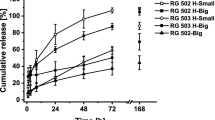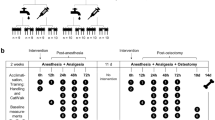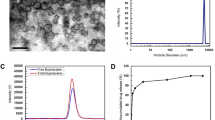Abstract
Providing adequate analgesia while minimizing handling and stress post-surgery can be challenging. Recently, there have been commercial products made available for providing long acting analgesia in rodents. However, we find there are limitations for use in mice due to the viscosity of the product and the small dosing volumes needed. This project evaluated an in-house compounded formulation of buprenorphine easily made in the laboratory using pharmaceutical grade products. The release of buprenorphine was evaluated when compounded with two types of hydrogels (Pluronic® F-127 and F-68). Mice given buprenorphine in hydrogel (BP) demonstrated higher serum levels of buprenorphine for a longer period of time compared to mice given standard buprenorphine (Bup). However, the rate of decline in serum levels between the groups was similar; thus, it is more likely that the higher buprenorphine concentration seen in the BP group is due to the higher dose of buprenorphine given, rather than a slower release of product. Feed consumption was decreased in both groups one day after dosing; however, there was no difference in body weights. Increased activity in the open field was observed with both buprenorphine formulations, and lipemia was observed in mice given BP which persisted to at least 96 h. Based on our results, we conclude that this formulation did not sustain the release of buprenorphine or eliminate the increased activity commonly seen in mice given buprenorphine. In addition, the lipemia may confound research parameters, especially in cardiac studies and lipid metabolism studies. Therefore, we cannot recommend this formulation for use.
This is a preview of subscription content, access via your institution
Access options
Subscribe to this journal
We are sorry, but there is no personal subscription option available for your country.
Buy this article
- Purchase on Springer Link
- Instant access to full article PDF
Prices may be subject to local taxes which are calculated during checkout






Similar content being viewed by others
References
Tubbs, J.T. et al. Effects of buprenorphine, meloxicam, and flunixin meglumine as postoperative analgesia in mice. J. Am. Assoc. Lab. Anim. Sci. 50, 185–191 (2011).
Cannon, C.Z., Kissling, G.E., Hoenerhoff, M.J., King-Herbert, A.P. & Blankenship-Paris, T. Evaluation of dosages and routes of administration of tramadol analgesia in rats using hot-plate and tail-flick tests. Lab Anim. (NY) 39, 342–351 (2010).
Cannon, C.Z., Kissling, G.E., Goulding, D., King-Herbert, A.P. & Blankenship-Paris, T. Comparison of analgesia effects of tramadol, carprofen, or multimodal analgesia in rats undergoing ventral laparotomy. Lab Anim. (NY) 40, 85–93 (2011).
Adamson, T.W. et al. Assessment of carprofen and buprenorphine on recovery of mice after surgical removal of the mammary fat pad. J. Am. Assoc. Lab. Anim. Sci. 49, 610–616 (2010).
Stokes, E.L., Flecknell, P.A. & Richardson, C.A. Reported analgesic and anaesthetic administration to rodents undergoing experimental surgical procedures. Lab. Anim. 43, 149–154 (2009).
Farris, H.E. Effects of indomethacin and buprenorphine analgesia on the postoperative recovery of mice. J. Am. Assoc. Lab. Anim. Sci. 47, 8 (2008).
Christoph, T. et al. Broad analgesic profile of buprenorphine in rodent models of acute and chronic pain. Eur. J. Pharmacol. 507, 87–98 (2005).
Kirsch, J.H., Klaus, J.A., Blizzard, K.K., Hurn, P.D. & Murphy, S.J. Pain evaluation and response to buprenorphine in rats subjected to sham middle cerebral artery occlusion. Contemp. Top. Lab. Anim. Sci. 41, 9–14 (2002).
Martin, L.B.E., Thompson, A.C., Martin, T. & Kristal, M.B. Analgesic efficacy of orally administered buprenorphine in rats. Comp. Med. 51, 43–48 (2001).
Flecknell, P.A. Post-operative analgesia in rabbits and rodents. Lab. Anim. 20, 34–37 (1991).
Goecke, J.C., Awad, H., Lawson, J.C. & Boivin, G.P. Evaluating postoperative analgesics in mice using telemetry. Comp. Med. 55, 37–44 (2005).
Carbone, E.T., Lindstrom, K.E., Diep, S. & Carbone, L. Duration of action of sustained-release buprenorphine in 2 strains of mice. J. Am. Assoc. Lab. Anim. Sci. 51, 815–819 (2012).
Yun, M.H. et al. Buprenorphine transdermal delivery system (BTDS): pharmacokinetic/pharmacodynamic modeling for analgesic effect in mice. Drug Metab. Rev. 38, 161 (2006).
Foley, P.L., Liang, H.X. & Crichlow, A.R. Evaluation of a sustained-release formulation of buprenorphine for analgesia in rats. J. Am. Assoc. Lab. Anim. Sci. 50, 198–204 (2011).
Chum, H.H. et al. Antinociceptive effects of sustained-release buprenorphine in a model of incisional pain in rats (Rattus norvegicus). J. Am. Assoc. Lab. Anim. Sci. 53, 193–197 (2014).
Kendall, L.V. et al. Efficacy of sustained-release buprenorphine in an experimental laparotomy model in female mice. J. Am. Assoc. Lab. Anim. Sci. 55, 66–73 (2016).
Seymour, T.L. et al. Postoperative analgesia due to sustained-release buprenorphine, sustained-release meloxicam, and carprofen gel in a model of incisional pain in rats (Rattus norvegicus). J. Am. Assoc. Lab. Anim. Sci. 55, 300–305 (2016).
Clark, T.S., Clark, D.D., Hoyt, J. & Robert, F. Pharmacokinetic comparison of sustained-release and standard buprenorphine in mice. J. Am. Assoc. Lab. Anim. Sci. 53, 387–391 (2014).
Escobar-Chavez, M.L.-C., Naik, A., Kalia, Y.N., Quintanar-Guerrero, D. & Ganem-Quintanar, A. Applications of thermo-reversible pluronic f-127 gels in pharmaceutical formulations. J. Pharm. Pharm. Sci. 9, 339–358 (2006).
Wenzel, J.G. et al. Pluronic F127 gel formulations of deslorelin and GnRH reduce drug degradation and sustain drug release and effect in cattle. J. Control. Release 85, 51–59 (2002).
Barichello, J.M., Morishita, M., Takayama, K. & Nagai, T. Absorption of insulin from pluronic f-127 gels following subcutaneous administration in rats. Int. J. Pharm. 184, 189–198 (1999).
Kabanov, A.V., Batrakova, E.V. & Alakhov, V.Y. Pluronic block copolymers as novel polymer therapeutics for drug and gene delivery. J. Control. Release 82, 189–212 (2002).
Nguyen, M.K. & Lee, D.S. Injectable biodegradable hydrogels. Macromol. Biosci. 10, 563–579 (2010).
Guarnieri, M., Tyler, B.K., DeTolla, L., Zhao, M. & B., K. Subcutaneous implants for long-acting drug therapy in laboratory animals may generate unintended drug reservoirs. J. Pharm. Bioallied. Sci. 6, 38–42 (2014).
Graves, R.A., Freeman, T. & Mandal, T.K. In vitro dissolution method for evaluation of buprenorphine in situ gel formulation: A technical note. AAPS PharmSciTech 8, 1 (2007).
Goldkuhl, R., Jacobsen, K.R., Kalliokoski, O., Hau, J. & Abelson, K.S. Plasma concentrations of corticosterone and buprenorphine in rats subjected to jugular vein catheterization. Lab. Anim. 44, 337–343 (2010).
Kalliokoski, O., Jacobsen, K.R., Hau, J. & Abelson, K.S.P. Serum concentrations of buprenorphine after oral and parenteral administration in male mice. Vet. J. 187, 251–254 (2011).
Jirkof, P., Tourvieille, A., Cinelli, P. & Arras, M. Buprenorphine for pain relief in mice: repeated injections vs sustained-release depot formulation. Lab. Anim. 49, 177–187 (2015).
Guarnieri, M. et al. Safety and efficacy of buprenorphine for analgesia in laboratory mice and rats. Lab Anim. (NY) 41, 337–343 (2012).
Neter, J., Kutner, M.H., Nachtscheim, C.J. & Waserman, W. Applied Linear Statical Models, 4th Edition. (WCB McGraw-Hill, 1996).
Tarasevich, B.J., Gutowska, A., Li, X.S. & Jeong, B.M. The effect of polymer composition on the gelation behavior of PLGA-g-PEG biodegradable thermoreversible gels. J. Biomed. Mater. Res. A 89, 248–254 (2009).
Hayes, K.E., Raucci, J.A., Gades, N.M. & Toth, L.A. An evaluation of analgesic regimens for abdominal surgery in mice. Contemp. Top. Lab. Anim. Sci. 39, 18–23 (2000).
Leach, M.C., Forrester, A.R. & Flecknell, P.A. Influence of preferred foodstuffs on the antinociceptive effects of orally administered buprenorphine in laboratory rats. Lab. Anim. 44, 54–58 (2010).
Jacobsen, K.R., Kalliokoski, O., Hau, J. & Abelson, K.S.P. Voluntary ingestion of buprenorphine in mice. Anim. Welf. 20, 591–596 (2011).
Thompson, A.C. et al. Analgesic efficacy of orally administered buprenorphine in rats: methodologic considerations. Comp. Med. 54, 293–300 (2004).
Speth, R.C., Smith, M.S. & Brogan, R.S. Regarding the inadvisability of administering postoperative analgesics in the drinking water of rats (Rattus norvegicus). Contemp. Top. Lab. Anim. Sci. 40, 15–17 (2001).
van Loo, P.L. et al. Analgsics in mice used in cancer research: reduction of discomfort? Lab. Anim. 31, 318–325 (1997).
Gillingham, M.B., Clark, M.D., Dahly, E.M., Krueger-Higby, L.A. & Ney, D.M. A comparison of two opioid analgesics for relief of visceral pain induced by intestinal resection in rats. Contemp. Top. Lab. Anim. Sci. 40, 21–26 (2001).
Liu, K.S. et al. Novel depots of buprenorphine prodrugs have a long-acting antinociceptive effect. Anesth. Analg. 102, 1445–1451 (2006).
Yun, M.H., Jeong, S.W., Pai, C.M. & Kim, S.O. Pharmacokinetic-pharmacodynamic modeling of the analgesic effect of bupredermTM, in mice. Health 2, 824–831 (2010).
Taylor, B.F., Ramirez, H.E., Battles, A.H., Andrutis, K.A. & Neubert, J.K. Angalgesic (Rattus norvegicus). J. Am. Assoc. Lab. Anim. Sci. 55, 74–82 (2016).
Kendall, L.V. et al. Pharmacokinetics of sustained-release analgesics in mice. J. Am. Assoc. Lab. Anim. Sci. 53, 478–484 (2014).
Wright-Williams, S.L., Courade, J.P., Richardson, C.A., Roughan, J.V. & Flecknell, P.A. Effects of vasectomy surgery and meloxicam treatment on faecal corticosterone levels and behaviour in two strains of laboratory mouse. Pain 130, 108–118 (2007).
Benedetti, M. et al. Plasma corticosterone levels in mouse models of pain. Eur. J. Pain 16, 803–815 (2012).
Shim, W.S. et al. pH- and temperature sensitive, injectable, biodegradable block copolymer hydrogels as carriers for paclitaxel. Int. J. Pharm. 331, 11–18 (2007).
Moore, T., Croy, S., Mallapragada, S. & Pandit, N. Experimental investigation and mathematical modeling of Pluronic F127 gel dissolution: drug release in stirred systems. J. Control. Release 67, 191–202 (2000).
Paavola, A., Kilpelainen, I., Yliruusi, J. & Rosenberg, P. Controlled release injectable liposomal gel of ibuprofen for epidural analgesia. Int. J. Pharm. 199, 85–93 (2000).
Park, I. et al. Buprederm, a new transdermal delivery system of buprenorphine: Pharmacokinetic, efficacy and skin irritancy studies. Pharm. Res. 25, 1052–1062 (2008).
Gopal, S., Tzeng, T. & Cowan, A. Characterization of the pharmacokinetics of buprenorphine and norbuprenorphine in rats after intravenous bolus administration of buprenorphine. Eur. J. Pharm. Sci. 15, 287–293 (2002).
Cirimele, V., Etienne, S., Villain, M., Ludes, B. & Kintz, P. Evaluation of the One-Step ELISA kit for the detection of buprenorphine in urine, blood, and hair specimens. Forensic Sci. Int. 143, 153–156 (2004).
Yassen, A., Olofsen, E., Dahan, A. & Danhof, M. Parmacokinetic-pharmacodynamic modeling of the antinociceptive effect of buprenorphine and fentanyl in rats: role of receptor equilibration kinetics. J. Pharmacol. Exp. Ther. 313, 1136–1149 (2005).
Wright-Williams, S., Flecknell, P.A. & Roughan, J.V. Comparative effects of vasectomy surgery and buprenorphine treatment on faecal corticosterone concentrations and behaviour assessed by manual and automated analysis methods in C57 and C3H mice. PLoS ONE 8, e75948 (2013).
Clark, M.D. et al. Evaluation of liposome-encapsulated oxymorphone hydrochloride in mice after splenectomy. Comp. Med. 54, 558–563 (2004).
Jacobsen, K.R., Kalliokoski, O., Teilmann, A.C., Hau, J. & Abelson, K.S.P. Postsurgical food and water consumption, fecal corticosterone metabolites, and behavior assessment as noninvasive measures of pain in vasectomized BALB/c mice. J. Am. Assoc. Lab. Anim. Sci. 51, 69–75 (2012).
Chappell, M.G., Koeller, C.A. & Hall, S.I. Differences in postsurgical recovery of cf1 mice after intraperitoneal implantation of radiotelemetry devices through a mid line or flank surgical approach. J. Am. Assoc. Lab. Anim. Sci. 50, 227–237 (2011).
Bourque, S.L., Adams, M.A., Nakatsu, K. & Winterborn, A. Comparison of buprenorphine and meloxicam for postsurgical analgesia in rats: effects on body weight, locomotor activity, and hemodynamic parameters. J. Am. Assoc. Lab. Anim. Sci. 49, 617–622 (2010).
Blaha, M.D. & Leon, L.R. Effects of indomethacin and buprenorphine analgesia on the post operative recovery of mice. J. Am. Assoc. Lab. Anim. Sci. 47, 8–19 (2008).
Sundbom, R., Jacobsen, K.R., Kalliokoski, O., Hau, J. & Abelson, K.S.P. Post-operative corticosterone levels in plasma and feces of mice subjected to permanent catheterization and automated blood sampling. In Vivo 25, 335–342 (2011).
Brennan, M.P., Sinusas, A.J., Horvath, T.L., Collins, J.G. & Harding, M.J. Correlation between body weight changes and postoperative pain in rats with with meloxicam or buprenorphine. Lab Anim. (NY) 38, 87–93 (2009).
Turner, P.V., Brabb, T., Pekow, C. & Vasbinder, M.A. Administration of substances to laboratory animals: routes of administration and factors to consider. J. Am. Assoc. Lab. Anim. Sci. 50, 600–613 (2011).
Cohier, C., Chevillard, L., Risede, P., Roussel, O. & Megarbane, B. Respiratory effects of buprenorphine/naloxone alone and in combination with diazepam in naive and tolerant rats. Toxicol. Lett. 228, 75–84 (2014).
Palmer, W.K., Emeson, E.E. & Johnston, T.P. Poloxamer 407-induced atherogenesis in the C57BL/6 mouse. Atherosclerosis 136, 115–123 (1998).
Blonder, J.M., Baird, L., Fulfs, J.C. & Rosenthal, G.J. Dose-dependent hyperlipidemia in rabbits following administration of poloxamer 407 Gel. Pharmacology Letters 65, 261–266 (1999).
Johnston, T.P., Nguyen, L.B., Chu, W.A. & Shefer, S. Potency of select statin drugs in a new mouse model of hyperlipidemia and atherosclerosis. Int. J. Pharm. 229, 75–86 (2001).
Wout, Z.G.M. et al. Poloxamer 407-mediated changes in plasma cholersterol and triglycerides following intraperitoneal injection in rats. PDA J. Pharm. Sci. Technol. 46, 192 (1992).
Hamad, I., Hunter, A.C. & Moghimi, S.M. Complement monitoring of pluronc 127 gel and micelles: suppression of copolymer-mediated complement activation by elevated serum levels of HDL, LDL, and apolipoproteins AI and B-100. J. Control. Release 170, 167–174 (2013).
Acknowledgements
This research was supported by the Intramural Research Program of the National Institutes of Health and the National Institute of Environmental Health Sciences. This article may be the work product of an employee or group of employees of the National Institute of Environmental Health Sciences (NIEHS), National Institutes of Health (NIH), however, the statements, opinions or conclusions contained herein do not necessarily represent the statements, opinions or conclusions of NIEHS, NIH or the United States government.
Author information
Authors and Affiliations
Contributions
T.L.B.-P. conceived of the project. T.L.B.-P., D.R.G., P.H.M. and J.W.D. designed the experiments. T.L.B.-P., D.R.G., P.H.M. and C.A.M. conducted the experiments. D.R.G. and G.E.K. analyzed the data. T.L.B.-P., D.R.G., P.H.M., and J.W.D. prepared the manuscript. T.L.B.-P. supervised the project.
Corresponding author
Ethics declarations
Competing interests
The authors declare no competing financial interests.
Rights and permissions
About this article
Cite this article
Blankenship-Paris, T., Dutton, J., Goulding, D. et al. Evaluation of buprenorphine hydrochloride Pluronic® gel formulation in male C57BL/6NCrl mice. Lab Anim 45, 370–379 (2016). https://doi.org/10.1038/laban.1106
Received:
Accepted:
Published:
Issue Date:
DOI: https://doi.org/10.1038/laban.1106



